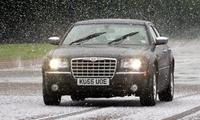Chrysler Jeep and Smart help drivers survive winter weather
 When the clocks change at the end of October the UK road network traditionally experiences a surge in road accidents. Snow, ice and wet weather all help contribute to an 18 per cent increase in accidents in the winter months.
When the clocks change at the end of October the UK road network traditionally experiences a surge in road accidents. Snow, ice and wet weather all help contribute to an 18 per cent increase in accidents in the winter months.Statistics show that 60 per cent of all fatal accidents in Europe are due to skidding while Euro NCAP recently advised consumers that stability control systems like ESP should be a top priority when buying a new car.
Electronic Stability Programme (ESP) compares the driver’s intended course, via steering angle and braking sensors, to the car’s actual course - by lateral acceleration, yaw and wheel speed sensors on each of the four wheels - and applies brakes on a single wheel or reduces engine power to restore the car to its original course.
DaimlerChrysler was the first car manufacturer to introduce a stability control system in its vehicles when it launched ESP on the Mercedes-Benz A-Class in 1997. Since DaimlerChrysler introduced ESP across its range of vehicles, the number of DaimlerChrysler brand vehicles involved in accidents where the driver loses control with no other external cause has decreased by 25 per cent.
ESP is a standard feature on the Jeep Grand Cherokee and Chrysler 300C and will be a standard feature on the MY06 Jeep Cherokee. From 2003, ESP has been available as standard on the smart fortwo and – with the exception of the 64bhp engine variant – from launch on the smart forfour.
Wilfried Steffen, Chief Executive of DaimlerChrysler UK said: "Traditionally, skid control systems have been reserved for large executive saloons. In the last 12 months however, DaimlerChrysler has introduced a number of new vehicles with ESP, meaning that the range of drivers able to benefit from this excellent safety system has increased significantly.
"The smart fortwo has ESP fitted as standard and this means that ESP is available to customers on a vehicle from as little as £6810. It is more common to find ESP as a cost-option in this segment, if it is available at all.
"If drivers are looking for the ultimate in safe and effective driving in rain, snow and ice then they should look no further than the latest Jeep Grand Cherokee and Jeep Cherokee vehicles. The four- wheel drive system on these vehicles already provides outstanding traction in the snow or on wet or icy tarmac. Adding a skid control system like ESP also means that once you have traction you can keep on the straight and narrow and brake much more effectively in all conditions."
The Jeep Cherokee is priced from £17,995 and Grand Cherokee from £29,495. The Chrysler 300C range starts from £25,750.
Wilfried Steffen added: "With weather forecasters predicting a harsh winter, with higher than normal snowfall this year, drivers should realise that safety on the roads isn’t just about having the latest vehicle technology.
"We probably all remember the images from March 2003 of thousands of motorists stranded on the M11 as vehicles crashed in the icy conditions. We should all make allowances for the weather conditions this winter by ensuring our car is properly maintained and perhaps think about carrying a winter driving kit."
Winter driving tips:
Try to start off in second gear and, once moving, use the highest gear possible to avoid wheel spin.
Allow more time to brake and accelerate and leave more room between the car you are driving and the car in front – stopping distances are doubled in the wet and it can take 10 times longer to stop in icy conditions than on a dry road.
Try to reduce speed gradually by decelerating rather than braking – avoid harsh braking and acceleration at all times.
Try to maintain a constant speed, choosing the most suitable gear in advance to avoid having to change down while climbing a hill.
When driving downhill, choose third or fourth gear to prevent skidding.
To brake on ice or snow without locking your wheels, get into a low gear earlier than normal, allow your speed to fall and use the brake pedal gently.
If you start to skid, ease off the accelerator but do not brake suddenly.
If you do need to make a journey in adverse weather conditions you should:
Ensure your vehicle’s battery is fully-charged and all of its electrical equipment, especially the lights and air conditioning, functions correctly.
Replace worn wiper blades – visibility will be at a premium in poor weather.
Make sure you have a full tank of fuel as you may need to run your engine whilst stationary for longer than normal.
Take a mobile phone with a fully-charged battery.
Take a thermos flask filled with hot soup or coffee/tea, some high energy foods such as chocolate or boiled sweets or even self-heating cans.
Wrap up warm and take a blanket, waterproof clothing and sensible footwear – changing from snow-covered boots into warm, dry footwear once in the car means your feet are less likely to slip on the pedals – another contributory factor to loss of control.
Besides carrying an ice scraper and de-icer, it's worth carrying a good quality torch, first aid kit, tow rope, jump leads, snow shovel, warning triangle, an old sack or rug and water repellent spray.
Take a pair of sunglasses – low winter sun, especially when it’s reflecting off snow or ice can be blinding.
Check the amount of grip on your tyres before you travel.
Try to use major routes if possible as these are more likely to have been gritted.


